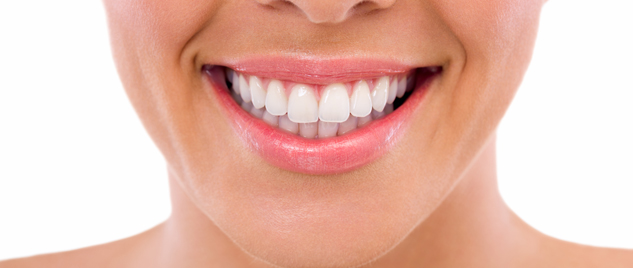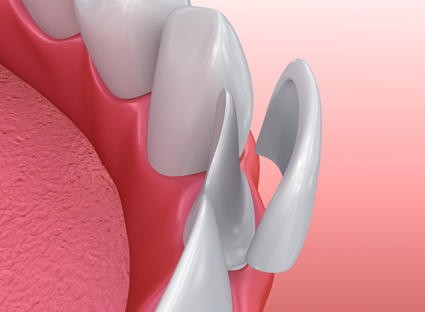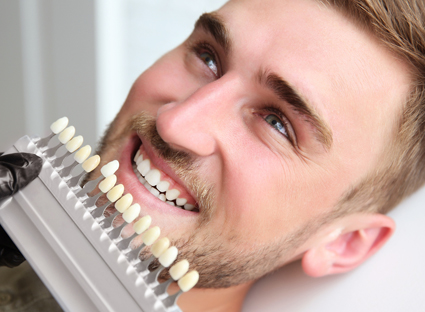COSMETIC DENTISTRY

VENEERS
Veneers in dentistry are personalised shells similar to artificial finger nails that fit over your teeth to improve their appearance, and give you that perfect white beautiful smile. Your dentist may suggest veneers as a treatment option if you have the following
- chipped teeth
- Stained teeth
- Misshaped teeth
- Treatment in conjunction with braces

There are 2 types of veneers that can be considered including porcelain or composite resin ‘plastic’ veneers.
- Porcelain veneers are more stain resistant, and mimic natural teeth better than the composite veneers.
- Composite veneers are thinner and less enamel needs to be removed before they are fitted onto your teeth.
What to expect at your veneer preparation appointment:
Generally composite veneer appointments can be done in one appointment after an initial consultation by your dentist, and proceed very much like having a filling. The initial consultation is important as it allows your dentist to determine your expectation for your new smile and which treatment option is best suited to your teeth.
Porcelain veneers require several more appointments including the following
- Preparation: your dentist will trim about half a millimeter of the tooth enamel to make space for the veneers. Then an impression or mould is taken of your teeth, this is then sent to a laboratory whereby your new veneers are made. This can take one to two weeks. In the interim, you will have temporary veneers to protect your teeth.
- Placement: Once the veneers are ready, your dentist will make sure that the veneers fit well on the teeth, and that the colour is satisfactory. The teeth are then cleaned, and a special white or clear cement is used to stick the veneer to the tooth.
- Review: your dentist will schedule a follow-up appointment to ensure that you are happy with your new smile and that the veneers are still fitting well.
You can expect veneers to last between 5 to 10 years, or more, with regular check ups, twice daily brushing and flossing.
Usually teeth whitening would be done prior to veneers, so that the veneers can be done at a very light shade, to get that great result.
TEETH WHITENING
Teeth whitening lightens the colour of your teeth, and is a great option to improve the look of your teeth and give you that dazzling bright, white smile. Whitening is not a one time procedure and will need to be repeated periodically to maintain the colour.
Your teeth can become discoloured or stained from the following :
- Smoking tobacco
- Drinking dark coloured drinks such as cola, red wine, coffee, tea
- Neglecting brushing your teeth adequately.
- Use of tetracycline antibiotics
Getting the best result:
Preparation is the key to getting the best results for whitening. If you are interested in whitening, or have a special event such as a wedding in mind, where you want to have whiter teeth, let your dentist know ahead of time so that any treatment can be planned with this in mind. It is necessary to get all required fillings and decay removed prior to whitening, or it will cause problems and pain and sensitivity on those teeth.
Prior to any method of whitening, a scale and polish is always required to remove any and all tartar and stain build up, ensuring a clean slate for effective whitening and better/brighter/whiter results. A pre-operative shade will always be taken so we can compare and track your before and after shade.
There are 2 ways whitening can be done:
- In-office whitening: your dentist will take pre-operation photos of your teeth first, this will allow him or her to monitor the progress of treatment. Your teeth will then be cleaned to remove all stains, tartar and plaque which affects the success of whitening.
- Take home whitening: a kit will be provided to you by your dentist. During the appointment impressions or moulds of your teeth will be taken so that personalized trays can be made that much the exact shape of your teeth. These trays allow a home whitening gel to be placed and applied everyday for two to three weeks. Follow the directions given to you by your dentist to avoid possible side effects and damage to your gums and teeth.
What to expect during a whitening appointment:

Although both types of whitening uses the same active ingredient- hydrogen peroxide, the concentration varies. In-office whitening usually has a higher concentration of hydrogen peroxide which allows for a more dramatic and instant result. A specialized UV light or laser activates the gel to make accelerate the whitening process.
An in-office whitening appointment will take between 1-2hours. The duration of the appointment is determined by how white you want your teeth and how severe the stains on your teeth are. In severe cases your dentist may ask you to use the take home whitening kit after the procedure.
At home, the custom tray is filled with gel and because the tray is customized to your mouth it ensures that the gel only touches the surface of the teeth and stays away from your gums. There are whitening products available over the counter at pharmacies or super markets but the concentration of the active ingredient is less than the products you can buy at the surgery.
Although whitening is one of the most common cosmetic procedures with a very good track record of safety there are still risks like with every procedure. Commonly gum irritation can occur, sensitivity that lasts from a few days to weeks. We take precaution to eliminate and minimize these by getting you to use sensitive toothpastes, and Tooth Mousse. With these, patients find little, or no teeth sensitivity.
Ensuring the best results:
After the procedure, try to avoid eating food or drinking drinks that can stain the teeth. Stick to white rice, fish, chicken, clear soups, creamy pasta sauces, drinking water and avoid foods such as coffee, tea, wine, soft drinks, fruits that can stain. If you wish to drink anything other than water use a straw. Avoid smoking.
It may be required later on to ‘top up’ the level of whitening of your teeth with time, ask your dentist.
